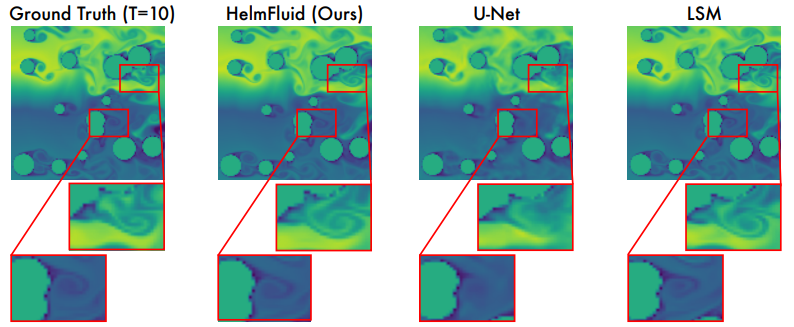HelmFluid: Learning Helmholtz Dynamics for Interpretable Fluid Prediction [paper]
Inspired by the Helmholtz theorem, we propose HelmFluid to learn curl-free and divergence-free parts of the fluid field,
- Inspired by the Helmholtz theorem, we propose the Helmholtz dynamics to attribute intricate dynamics into inherent properties of fluid, which empowers the prediction process with physical interpretability.
- We propose HelmFluid with the HelmDynamics block to capture Helmholtz dynamics. By integrating learned dynamics along temporal dimension with the Multiscale Multihead Integral Architecture, HelmFluid can predict future fluid with physically plausible evidence.
- HelmFluid achieves consistent state-of-the-art in five extensive benchmarks, covering both synthetic and realworld datasets, as well as various boundary conditions.

Figure 1. Overview of HelmFluid.
- Different from previous methods that directly learning fluid dynamics, HelmFluid decomposes the intricate dynamics into more solvable parts, which facilitates our model with physical interpretability.
- Different from neural fluid simulators like PDE solvers, HelmFluid is as purely data-driven model but with special designs to enhance physical interpretability.
- Unlike computer graphics for fluid simulation, HelmFluid is an end-to-end method to learn intrincate dynamics without ground truth velocity supervision nor stream function.

Figure 2. Comparison on dynamics and fluid modeling.
- Install Python 3.8. For convenience, execute the following command. You may change the version of cupy according to your own environment.
pip install -r requirements.txt- Data preparation.
Download the datasets from the following links and put them under the folder
./data/.
| Dataset | Task | Link |
|---|---|---|
| Navier-Stokes | Predict future fluid vorticity | [Google Cloud] |
| Bounded N-S | Predict future color | [Google Cloud] |
| ERA5 Z500 | Predict future geopotential | [Google Cloud] |
| Sea Temperature | Predict future sea temperature | [Google Cloud] |
| Spreading Ink | Predict future fluid video | [Google Cloud] |
- Train and evaluate model. We provide the experiment scripts of all benchmarks under the folder
./scripts/. You can reproduce the experiment results as the following examples:
bash scripts/Bounded_NS_HelmFluid.sh # for Bounded N-S
bash scripts/ERA5_Z500_HelmFluid.sh # for ERA5_Z500
bash scripts/Navier_Stokes_HelmFluid.sh # for Navier-Stokes
bash scripts/Sea_Temperature_HelmFluid.sh # for Sea Temperature
bash scripts/SpreadingInk_HelmFluid.sh # for Spreading InkNote: You need to change the argument --data-path in the above script files to your dataset path.
- Develop your own model. Here are the instructions:
- Add the model file under folder
./models/. - Add the model name into
./model_dict.py. - Add a script file under folder
./scripts/and change the argument--model.
- Add the model file under folder
Note: For clearness and easy comparison, we also include the FNO in this repository.
We extensively experiment on seven benchmarks and compare LSM with 13 baselines. LSM achieves the consistent state-of-the-art in both solid and fluid physics (11.5% averaged error reduction).

Table 1. Model performance for Navier-Stokes dataset. Relative L2 is recorded.

Figure 3. Showcases for Navier-Stokes dataset. HelmFluid precisely predicts the fluid motion, especially the twist parts.

Figure 3. Showcases for Bounded N-S dataset. HelmFluid succesfully captures the Karmen vortex phenomenon.
If you find this repo useful, please cite our paper.
@inproceedings{xing2024HelmFluid,
title={HelmFluid: Learning Helmholtz Dynamics for Interpretable Fluid Prediction},
author={Lanxiang Xing and Haixu Wu and Yuezhou Ma and Jianmin Wang and Mingsheng Long},
booktitle={International Conference on Machine Learning},
year={2024}
}
If you have any questions or want to use the code, please contact xlx22@mails.tsinghua.edu.cn.
We appreciate the following github repos a lot for their valuable code base or datasets:
https://github.com/neuraloperator/neuraloperator
https://github.com/yitongdeng-projects/learning_vortex_dynamics_code